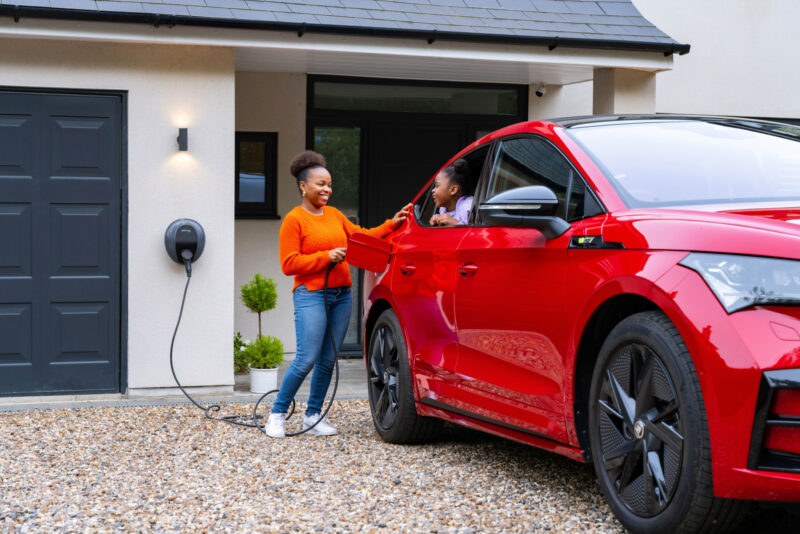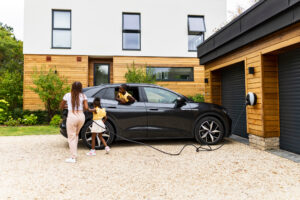Vehicle-to-Grid (V2G) Explained
A guide explaining the concept of vehicle-to-grid charging and exploring the benefits and drawbacks of this technology.
Last updated: Jun 13, 2025 • 7 min read

Vehicle-to-grid (V2G) allows electricity to flow two ways between an electric car battery and the electricity grid. This helps balance supply and demand better and reduce the risk of power cuts, and also offers drivers the ability to sell any excess energy back to the grid.

Vehicle-to-grid (V2G), sometimes mistakenly called bi-directional charging, refers to technology that enables the energy that’s used to charge an electric vehicle to go out of an electric vehicle’s battery and back into the grid.
It’s important to the EV industry, and more widely the energy industry, because of its prospects in allowing us to manage energy demand better whilst balancing the UK’s overall energy system.
What is vehicle-to-grid?
Apart from a very select few, most EV chargers can only discharge energy in one direction, that being from the home’s energy supply and into the battery, where it is stored ready for use later. This has historically been sufficient to allow people to charge their electric cars at home.
The concept of V2G, however, is to give EV drivers the ability to push the stored energy in their car’s battery back into the grid. In particular, it’s meant for periods when energy demand is high, giving drivers a way to effectively ‘sell’ their stored energy in their EV batteries back to the grid, potentially for a profit.
This effectively turns EV drivers from electricity consumers to a more hybrid role of part-energy consumer, part-energy storage, and even part-energy provider.
How does V2G work?
V2G works by taking advantage of bi-directional charging, which is simply the technology that makes it possible to both charge the battery and draw energy from it. However, there are very few chargers available at the moment that use bi-directional charging, and similarly few electric cars that are capable (yet) of discharging energy.
Tip: V2G and bi-directional charging are often used synonymously, but it’s good to know that they mean different things. Bi-directional simply means two-way charging (or charging and discharging), whilst V2G is technology specifically to draw energy from the battery back into the grid.
Are all EVs compatible with V2G?
A number of carmakers produce V2G-capable cars such as Nissan, Mercedes Benz and Honda. Although the technology is mostly ready, adaptation among EV drivers is low, because V2G technology requires the use of a CHAdeMO plug, which is typically not available for home chargers.
Why does V2G matter?
In theory, vehicle-to-grid has huge potential and could come with a number of big benefits:
V2G could save drivers money
The old saying ‘buy low sell high’ sums up V2G’s savings potential. Simply put, the theory is that you could charge your EV when demand (and thus prices) for energy are lower, and then sell that energy back to the grid when demand (and again prices) goes up.
However, to benefit from this, drivers would need all of the following to benefit:
- Enough energy in the battery to sell
- A compatible EV charger that is bi-directional capable
- A compatible EV that’s also capable of bi-directional charging
- A V2G tariff
The first point isn’t much of an issue, given cars are parked for about 95% of their time and the average daily car journey is less than 8 miles (according to the National Travel Survey 2022). This means it’s quite likely the car is already sitting there with plenty of charge left. However, the remaining three are in short supply. Few chargers or electric cars are capable of bi-directional charging, and, as of writing, only one vehicle-to-grid tariff exists: the Octopus Power Pack tariff.
V2G could be great for the environment
How we generate and use energy has become a huge topic for mitigating climate change. So far, most efforts have been geared towards decarbonisation – that is, lowering the carbon emissions generated when we create energy, with renewables playing a significant role in this.
V2G technology could have a similarly big impact because it in theory allows the grid to draw on the existing energy stored in our cars (i.e. on our driveways) when demand for energy is high, rather than producing more energy, which means fewer emissions and greater energy efficiency. Put simply, V2G essentially makes EVs essentially energy storage on wheels that can both charge and discharge when needed, helping the UK’s Electricity System Operator (ESO) from having to turn on extra power stations to cope (and avoiding blackouts).
What are the concerns with V2G?
In theory, V2G technology sounds like a no-brainer, benefitting both consumers and the planet. However, the technology is still a long way off from being a staple of UK households, as it’s still very much in its infancy.
Implementation costs
Making an electric car or its charger capable of supporting V2G will undoubtedly make both more expensive, potentially even outweighing any financial benefits, or at least making the time it takes to pay it back much longer.
That said, EVs already have a battery storage system, so it would be much more cost-effective to use them instead of implementing an alternative (and likely much more expensive) system. This is doubly true considering battery prices are falling fast, and if you’ve already spent the money on one (by buying an EV), you can reduce your spend.
Charging hardware
Currently only the “CHAdeMO” DC connector is capable of V2G. However, it’s not currently used in homes because most homes only have single-phase power (which is AC, not DC). It’s also not by any means a universal connector. If V2G technology becomes viable in the mainstream, there would need to be agreed standards between various car manufacturers, which could be challenging to establish.
Battery degradation
Any battery, whether it’s in an EV or not, will naturally degrade over time because of how charging cycles work. It’s thought that battery degradation could increase if it’s used both to receive and provide energy, which in turn would affect the car’s effective driving range or even its residual value.
However, there are some theories suggesting using EV batteries for V2G may in fact improve battery longevity by ensuring the battery is kept in an optimal charge state. This is because over-charging a battery, or keeping it with a high level of charge for extended periods of time can harm the battery.
The reality is, we still don’t fully understand how practical using EV batteries for V2G is in terms of degradation, but there’s no doubt it has potential (positive or negative).
EVs use the energy they store
It should go without saying that if you’ve charged your EV, it’s probably because you intend to use it (using up the energy you’ve stored in the battery in the process). V2G only really works if there are enough EVs not currently driving when demand is high (in turn giving the grid energy to draw from).
Whilst we have plenty of insights to draw on in terms of driving habits, EVs (and their batteries) are still an intermittent and unpredictable power source. In other words, it’s only going to give drivers the ability to make some money if they don’t use it which, inevitably, they at some point will.
Alternative ways to save money or store energy
Simply using high powered devices at night (e.g. washing machines, dryers, charging EVs) could provide savings in a similar way to V2G, with no significant implementation costs. Additionally, having a fixed battery storage system at home will provide all the proposed benefits of the V2G system with none of the systematic constraints – and the cost of these systems is reducing fast.
Can I use my EV to power my house?
Vehicle-to-house (V2H) charging is based on the same bi-directional principles as V2G. While an EV battery would be capable of powering a home for several days, the technology isn’t available yet.


